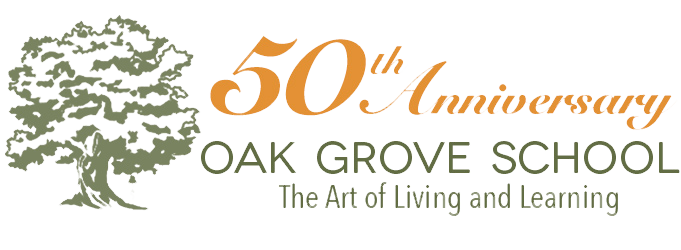The student newspaper is a great way for students to engage with peers on important topics and to find a communal voice for change, as well as to develop their own individual voices.
The intention of Pastoral Care Time is to honor the start of a new day, to mark the transition from home to school.
Oak Grove high school students collaborate with government agencies in a clean-up effort.
Often, people visit Oak Grove School for the first time and share a feeling of peacefulness, of oneness, of familiarity.
Enjoy video and photos from our 2021 high school graduation ceremony!
Oak Grove families and friends gathered on campus for a socially-distanced outdoor screening of our all-school musical production of Matilda.
“Our Pandemic Story,” installed inside the school’s new Reflective Classroom, gives students, families and staff the opportunity to share their individual pandemic stories and to create a shared, community-wide story, according to Head of School Jodi Grass.
Humans are social animals. Does the quantity and quality of our social relationships impact our state of health, future risk of disease, and our life span? Are the effects of relationships via social media the same or different from those of in-person relationships? Please join our presenter Dr. Pathik Wadhwa in a discussion that will touch on the biological and behavioral science behind social relationships, both in-person and virtual.
Former Head of School, Meredy Benson Rice, now the Director of Teaching and Learning spoke about her personal journey as an educator and how students experience education at Oak Grove School as part of the 2015 Do Lecture Series.
If you were not able to join us for this timely Parent Education event, or would like to review, we have provided this recording of parenting expert Dolly Klock’s special presentation on the challenge of finding a balance between screen life and real life. The recording includes attending parents’ Q&A.
CONTACT OAK GROVE
Oak Grove School of the Krishnamurti Foundation of America
CALL: 805 646 8236
EMAIL: info@oakgroveschool.org
MAIL: 220 West Lomita Avenue
Ojai, California 93023-2244
Latest News
 NYC VisitOctober 28, 2025 - 3:38 pm
NYC VisitOctober 28, 2025 - 3:38 pm Garden Dispatch: Autumn ColorsOctober 28, 2025 - 12:55 pm
Garden Dispatch: Autumn ColorsOctober 28, 2025 - 12:55 pm Thank You, Ojai!October 21, 2025 - 9:25 am
Thank You, Ojai!October 21, 2025 - 9:25 am Peace Week 2025September 29, 2025 - 3:02 pm
Peace Week 2025September 29, 2025 - 3:02 pm First Day of School 1975September 25, 2025 - 12:59 pm
First Day of School 1975September 25, 2025 - 12:59 pm
Non-Discrimination Policy
Oak Grove School does not discriminate on the basis of any individual or group identity characteristics, such as but not limited to race, color, gender identity or expression, sexual orientation, age, national or ethnic origin, differing mental or physical abilities, or family structure in the administration of its educational or admissions policies, employment practices, scholarship, and other school-administered programs. View the unabridged policy.


